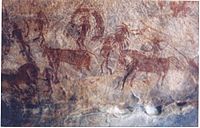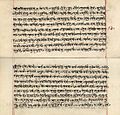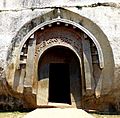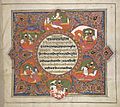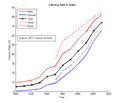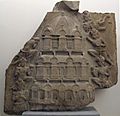History of India facts for kids
The history of India covers thousands of years. It covers many periods and dynasties. It may be divided in the following parts:
Contents
Stone age
Paleolithic era
Remains (stone tools and a skull) in central India show presence of an early species of man, Homo erectus. Archeologists think they lived in India between 200,000 to 500,000 years ago. This period is known as the paleolithic era. Evolution of its crust shows four stages and the fourth stage is known as Quaternary which is further divided into Pleistocene and Holocene
The earliest archaeological site in the subcontinent is the paleolithic hominid site in the Soan River valley. Soanian sites are found in the Sivalik region across India, Pakistan, and Nepal.
Mesolithic
Modern humans (Homo sapiens) settled in the Indian subcontinent at least 12,000 years ago. At that time the last Ice Age had just ended and climate became warm and dry. First settlements of human beings in India are found in Bhimbetka, a place near Bhopal (Madhya Pradesh, India).Mesolithic people lived on hunting , fishing and food gathering
Neolithic
Neolithic agriculture sprang up in the Indus Valley region around 7000 years ago, in the lower Gangetic valley around 5000 years ago. Later, in South India, agriculture spread southwards and also into Malwa around 3800 years ago.
Chalcolithic
It covered the regions of modern Maharastra except the part of vidarbha and the coastal region of konkan
Bronze Age
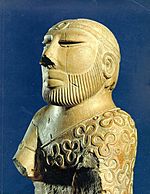
The Bronze Age in the Indian subcontinent began around 5300 years ago with the early Indus Valley Civilisation( include cities like Harappa , Mohenjodaro, Lothal , Kalibanga ). It was centred on the Indus River and its tributaries which extended into the Ghaggar-Hakra River valley, the Ganges-Yamuna Doab, Gujarat, and southeastern Afghanistan. The civilisation is mainly in modern-day India (Gujarat, Haryana, Punjab and Rajasthan provinces) and Pakistan (Sindh, Punjab, and Balochistan provinces).
The first cities in the subcontinent were in the Indus Valley Civilisation. It is one of the world's earliest urban civilisations, with Mesopotamia and Ancient Egypt. Inhabitants of the ancient Indus river valley, the Harappans, developed new techniques in metallurgy and handicraft (carneol products, seal carving), and produced copper, bronze, lead, and tin.
The mature Indus civilisation flourished from about 4600 to 3900 years ago. It was the start of urban civilisation on the subcontinent. The civilisation included urban centres such as Dholavira, Kalibanga, Ropar, Rakhigarhi, and Lothal in modern-day India, and Harappa, Ganeriwala, and Mohenjo-daro in modern-day Pakistan. The civilisation is noted for its cities built of brick, roadside drainage system, and multistoried houses.
During the later period of this civilisation, signs of a gradual decline began to emerge. By about 3700 years ago, most of the cities were abandoned. However, the Indus Valley Civilisation did not disappear suddenly. Some parts of the Indus Civilization may have survived in the smaller villages and isolated farms.
Vedic civilization
The Vedas are the oldest teachings of India, though the transmission of these teachings was mainly oral until around the 5th century. There are four Vedas, and the first one is the Rigveda. As per Rigved the whole regions in which the Aryans were first settled in India which was called as the Land of 7 Rivers or SaptaSindhawa .The other three are Samveda, Yajurveda and Atharvaveda. The Vedas have verses in praise of gods and others. They also have other information. At that time, the society was pastoral.
After the Rigveda, society became more agricultural. People became divided into four classes depending on the type of the work. Brahmins were priests and teachers. Kshatriyas were the warriors. Vaishyas did agriculture, trading and commerce. The shudras were the general working class. A common misconception is that the Vaishyas and Shudras were generally looked down upon, and treated badly by Brahmins and Kshatriyas, which was true for the later part of the Vedic age. But was untrue for the earlier part. This type of social division is called the Varna system in Hinduism.
During the period of the Vedic civilization, there were many Aryan clans and tribes. Some of them combined and became bigger like the kingdom of the Kurus.
Persian and Greek invasion
Around the 5th century BC, north-western parts of India faced invasion by the Achaemenid Empire and by the Greeks of Alexander the Great. A Persian way of thinking, administration and lifestyle came to India. This influence became bigger during the Mauryan dynasty.
From around 520 BC, the Achaemenid Empire’s Darius I ruled large part of northwestern parts of the Indian subcontinent. Then Alexander conquered these areas. Herodotus, a historian of that time, has written that these areas were the richest areas of Alexander’s Empire. Achaemenid rule lasted about 186 years. In modern times, there are still traces of this Greek heritage to be found in parts of northwestern India.
Greco-Buddhism (also spelt as Græco-Buddhism) is a combination of the cultures of Greece and Buddhism. This mixture of cultures continued to develop for 800 years, from the 4th century BC until the 5th century AD. The area where it happened is modern day’s Afghanistan and Pakistan. This mixture of cultures influenced Mahayana Buddhism and spread of Buddhism to China, Korea, Japan and Tibet.
The Magadha empire
The Magadha formed one of the sixteen kingdoms in ancient India. The core of the kingdom was the area of Bihar south of the Ganges. Its first capital was Rajagriha (modern Rajgir) then Pataliputra (modern Patna).
Magadha expanded to include most of Bihar and Bengal, followed by much of eastern Uttar Pradesh and Orissa. The ancient kingdom of Magadha is mentioned in Jain and Buddhist texts. It is also mentioned in the Ramayana, Mahabharata, Puranas. A state of Magadha, possibly a tribal kingdom, is recorded in Vedic texts much earlier than 600 BC.
Magadha played an important role in the development of Jainism and Buddhism, and two of India's greatest empires, the Maurya Empire and Gupta Empire, originated from Magadha. These empires saw advances in ancient India's science, mathematics, astronomy, religion, and philosophy. This was the Indian "Golden Age".
Early middle kingdoms
Satavahana empire
The Satavahanas came to power from around 230 BC. They are also called Andhras. For about 450 years, many Satavahanas kings ruled most parts of the southern and central India.
Western Kshatrapas
For about 350 years, from the years 35-405, Saka kings ruled India. They ruled the western and central parts of India. These areas are in today's states of Gujarat, Maharashtra, Rajasthan, and Madhya Pradesh. There were 27 independent rulers, collectively known as the Kshatrapas.
Saka kings ruled India along aside the Kushan kings and the Satvahana kings. Kushan kings ruled the northern parts of India. Satvahana kings ruled the central and some of the southern parts of India.
Indo-Scythians
Indo-Scythians came to India from Siberia passing through several places like Bactria, Sogdiana, Kashmir and Arachosia. Their coming to India continued from the 2nd century BC to the 1st century BC. They defeated the Indo-Greek rulers of India, and ruled India from Gandhara to Mathura.
Gupta dynasty
The Gupta dynasty reigned from around 320 to 550 AD. The Gupta Empire covered most of North-central India, the region Gupta Empire (never included Pakistan); and what is now western India and Bangladesh. Gupta society was ordered in accordance with Hindu beliefs. The time of the Gupta Empire is seen as the Golden Age of India. Historians place the Gupta dynasty alongside the Han Dynasty, Tang Dynasty and Roman Empire as a model of a classical civilization.
Hun invasion

By the first half of the fifth century, a group of people known as Huns had settled in Afghanistan. They became powerful. They made Bamiyan as their capital city. They started attacking northwestern parts of India. Skandagupta, an emperor of the Gupta dynasty fought back and kept them away for some years. At last the Huns won and could enter most parts of northern India. With this the Gupta dynasty came to an end. Most of north India became badly affected by this invasion. However, Huns could not go up to the Deccan Plateau and the southern parts of India. These parts remained peaceful. No one knows definitely about the fate of Huns after the end of the sixth century. Some historians believe that they mixed up fully with the Indian people of that time.
Late Middle Kingdoms
In the history of India, Middle kingdoms of India covers a period beginning from around the 6th-7th century. In South India, Chola kings ruled Tamil Nadu, and Chera kings ruled Kerala. They also had trading relationships with the Roman Empire to the west and Southeast Asia to the east. In north India, Rajputs ruled in many kingdoms. Some of those kingdoms continued for hundreds of years.
Harsha's empire
After the collapse of the Gupta Empire, it was Harsha of Kanauj (a place now in Uttar Pradesh state of India) who united the northern parts of India in one kingdom. After his death several dynasties tried to control north India and ruled from time to time from 7th century till the 9th century as described in some of the sections below. Some of these dynasties were the Pratiharas of Malwa and later Kannauj; the Palas of Bengal, and the Rashtrakutas of the Deccan.
The Pratiharas, Palas, and Rashtrakutas
The Pratihara kings ruled kingdoms in Rajasthan and some other parts of northern India from the 6th century to the 11th century. The Palas ruled the eastern part of India. They ruled over areas which are now parts of the Indian states of Bihar, Jharkhand, and the west Bengal, and of Bangladesh. The Palas ruled from 8th century to the 12th century. In the southern parts of India, Rashtrakutas of Malakheda (Karnataka) ruled the Deccan during the 8th-10th centuries after the end of Chalukya rule. All these three dynasties always tried to control the entire north India. During all this time lasting for three to four hundred years, the Chola kings were growing in power and influence.
The Rajputs
In the 6th century several Rajput kingdoms came into being in Rajasthan. Many other Rajput kings ruled in different parts of north India. Some of these kingdoms continue to survive for hundreds of years during different periods of the history of India.
Vijayanagar empire
In 1336, two brothers named Harihara and Bukka founded the Vijayanagara Empire in an area which is now in Karnataka state of India. The most famous king of this empire was Krishnadevaraya. In 1565, rulers of this empire were defeated in a battle. But, the empire continued for about next one hundred years.
A number of kingdoms of south India had trading relations with the Arabs in the west, and with Indonesia and other countries of the east.
Islamic sultanates
Islam spread across the Indian subcontinent over a period of 500 years. In the 10th and 11th centuries, Turks and Afghans invaded India and established sultanates in Delhi. In the early 16th century, descendants of Genghis Khan swept across the Khyber Pass and established the Mughal Empire, which lasted for 200 years. From the 11th to the 15th centuries, southern India was dominated by Hindu Chola and Vijayanagar Dynasties. During this time, the two systems—the prevailing Hindu and Muslim—mingled, left lasting cultural influences on each other.
Delhi sultanate
Slave dynasty was started by Qutub ud din Aibak. He was the one who started the first architectural monument of the slave dynasty or rather the first architectural work of Muslims in India which was Qutub Minar. Qutub ud din Aibak died while playing chaugan(modern day polo)as he fell from his horse. He was succeeded by Iltumish who completed the Qutub Minar. He was succeeded by his daughter Razia Sultan who became the first woman ruler. Though she reigned for only three years, she introduced various reforms in her tenure.
The Kingdom of Mysore
The Kingdom of Mysore was a kingdom of southern India. People known as Wodeyars founded this kingdom in the year 1400. Later on, Hyder Ali and his son, Tipu Sultan, fought with the Wodeyar rulers. They also fought with the forces of the British Raj, but were defeated. Under the British Raj, Wodeyar kings continued to rule a large part of Karnataka. When India became independent on 15th August 1947, Wodeyars’ kingdom chose to become a part of India.
The Punjab
Guru Nanak founded Sikhism and his followers were called Sikhs. The power of Sikhs continued to increase in the northwestern part of India. The Sikhs became rulers of large part of the northwestern India. This is called the Sikh Kingdom or Empire. Ranjit Singh was the most famous ruler of the Sikh Empire. He expanded the borders of the Sikh Empire and at the time of his death, this empire covered areas of Punjab, and present day Kashmir and parts of Pakistan. The Sikhs and forces of the British Raj fought many wars. Till Maharaja Ranjit Singh was alive, Britishers were not able to cross the Sutlej river. After his death, the they took over the entire Punjab after battles with disorganised sikh troops.
Durrani Empire
For a short period, a person named Ahmed Shah Durrani ruled some parts of northwestern India. Historians have named his rule as the Durrani Empire. In 1748, he crossed the Indus River and attacked Lahore, now a part of Pakistan. He also attacked many parts of Punjab. Then, he attacked Delhi. At that time, Delhi was the capital of the Mughal Empire. He took many valuable things from India. This included the famous diamond named Kohinoor.
Colonial era
Colonial period means the period during which Western countries ruled India. These countries also ruled many other countries of Asia, Africa, and South America.
Company Raj
Starting in the 1600's the British East India Company began a very profitable trading empire in India, centered in Bengal. In the mid-1700's Robert Clive (1725-1774) lead the Company to an expanded influence in India with victories over the French, the Bengalis, and the Mughals. With a victory at the Battle of Plassey in 1757 Clive became the first British Governor of Bengal.
In the hundred years after the battle, the East India Company conquered the entire subcontinent of India. They did this by trade, political intrigue, and direct military action. The British were very efficient administrators of their domains. But in 1857 the Indian Mutiny almost destroyed the Company's rule of India. Afterward the British government took control away from the Company. In 1858, India became a part of the British Empire and Queen Victoria became the empress of India.
The British Raj
For ninety years the British ruled India and Burma as a unified territory under the British king or queen. It was divided into eight provinces each with a governor. These provinces were Burma, Bengal, Madras, Bombay, UP, Central Provinces, Punjab, and Assam. A Governor-General (Viceroy) in Calcutta was head of the government.
The British did some very harmful things to the culture and society. They took valuables, and tortured many Indians. The way they conquered India was often divide and rule. In the end, many kingdoms were defeated by the British and the riches taken. For example, many of the Royal Crown Jewels were taken from previous kingdoms in India- including the Koh-I-Noor diamond (one of the worlds largest diamonds) and also stole many other large diamonds and gold.
During famines and floods many people died because the government did not help enough. Any Indian not able to pay the British taxes, could be forced into prison and/or publicly beaten. Political opponents were jailed and sometimes killed for speaking out against colonial rule. After taking much of the India's natural resources for hundreds of years, England was criticized for not protecting Indians during the partition of India and Pakistan. During the partition of India and Pakistan, millions of Indians and Pakistanis died.
The British also did good things. They built railroads, telegraphs and telephones, improved trade, standardized laws, and water supplies. Many of these things were done to help improve commerce in India and taxes provided to England. They created the Indian Civil Service for administering rules and regulations. They also tried to eliminate practices like burning widows.
The British ruled India primarily for the economic benefit of Britain. India produced cheap raw materials for British industry. Indians had to buy British manufactured goods and profits went back to Britain.
The independence movement
Many people in India wanted to be free from British rule. The struggle for independence was long and difficult. The most important leader of the struggle for Indian independence was Mahatma Gandhi. Gandhi believed in a non-violent opposition towards the British.
India won its independence, along with Muslim Pakistan, and became a free country on August 15, 1947.
Republic of India
On 15 August 1947, British Indian Empire was partitioned into two countries, India (Hindustan) and Pakistan. With this the British Raj in the Indian subcontinent ended. On 26 January 1950, Hindustan adopted a constitution. From that day, Hindustanis became the Republic of India or Indians.
During last 60 years, Republic of India has seen different stages in its national life. Some of them are as follows:
- It fought three wars against Pakistan, and one war against China. Wars with Pakistan were fought in 1947, 1965, and 1971. In 1999, it had a limited skirmish in Kargil. The war with China was fought in 1962. In 1971, the Republic of India also helped Bangladesh in its freedom struggle.
- Under the leadership of Jawaharlal Nehru (the first Prime Minister of India), India had adopted a socialist economy. Some economists think it was a mixed economy. In a mixed economy, socialism and capitalism continue together. During this period, lasting for several years up to end-1980s, India could rapidly develop its infrastructure, science and technology.
- By the early 1990s, India had changed its economic policies. It started several reforms to attract more capital from other countries. Local businessmen and industrialists also got more freedom to carry out their activities.
- In 1974, India had already detonated its first nuclear bomb. It repeated the same in 1998. With this, it became a nuclear power.
Presently (As of 2006[update]), India is currently the tenth largest economy in terms of gross GDP. It is the 4th largest economy of the world when accounting for purchasing power parity. Some economists think that in coming decades, India’s economy will become still larger.
Other pages
Images for kids
-
Mehrgarh site, in Beluchistan, Pakistan
-
Mohenjo-daro, one of the largest Indus cities. View of the site's Great Bath, showing the surrounding urban layout.
-
Dholavira, a city of the Indus Valley civilisation, with stepwell steps to reach the water level in artificially constructed reservoirs.
-
Archaeological remains of washroom drainage system at Lothal
-
Three stamp seals and their impressions bearing Indus script characters alongside animals: "unicorn" (left), bull (center), and elephant (right); Guimet Museum
-
An early 19th century manuscript in the Devanagari script of the Rigveda, originally transmitted orally with fidelity
-
Manuscript illustration of the Battle of Kurukshetra.
-
The Mahajanapadas were the sixteen most powerful and vast kingdoms and republics of the era, located mainly across the Indo-Gangetic plains.
-
Silk Road and Spice trade, ancient trade routes that linked India with the Old World; carried goods and ideas between the ancient civilisations of the Old World and India. The land routes are red, and the water routes are blue.
-
Coin of Emperor Harsha, c. 606–647 CE.
-
Excavated ruins of Nalanda, a centre of Buddhist learning from 450 to 1193 CE.
-
The Delhi Sultanate reached its zenith under the Turko-Indian Tughlaq dynasty.
-
The Dasam Granth (above) was composed by Sikh Guru Gobind Singh.
-
Jain Tirthankara Mahavira with Yaksha Matanga and Yakshi Siddhaiki at Ellora Caves.
-
Brihadeeswara Temple Entrance Gopurams at Thanjavur.
-
Gol Gumbaz built by the Bijapur Sultanate, has the second largest pre-modern dome in the world after the Byzantine Hagia Sophia.
-
The Red Fort, Delhi, its construction begun in 1639 CE, and ended in 1648 CE.
-
Watercolor (1863) titled, The Ganges Canal, Roorkee, Saharanpur District (U.P.). The canal was the brainchild of Sir Proby Cautley; construction began in 1840, and the canal was opened by Governor-General Lord Dalhousie in April 1854
-
Bahadur Shah Zafar the last Mughal Emperor, crowned Emperor of India by the rebels, he was deposed by the British, and died in exile in Burma
-
Srinivasa Ramanujan (1887–1920) was an Indian mathematician who made seminal contributions to number theory.
-
India Gate is a memorial to 70,000 soldiers of the British Indian Army who died in the period 1914–21 in the First World War.
-
From the late 19th century, and especially after 1920, under the leadership of Mahatma Gandhi (right), the Congress became the principal leader of the Indian independence movement. Gandhi is shown here with Jawaharlal Nehru, later the first prime minister of India.
-
Jawaharlal Nehru being sworn in as the first prime minister of independent India by viceroy Lord Louis Mountbatten at 8:30 AM 15 August 1947.
See also
 In Spanish: Historia de la India para niños
In Spanish: Historia de la India para niños


